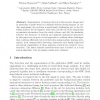Free Online Productivity Tools
i2Speak
i2Symbol
i2OCR
iTex2Img
iWeb2Print
iWeb2Shot
i2Type
iPdf2Split
iPdf2Merge
i2Bopomofo
i2Arabic
i2Style
i2Image
i2PDF
iLatex2Rtf
Sci2ools
MICCAI
2010
Springer
2010
Springer
Guide-Wire Extraction through Perceptual Organization of Local Segments in Fluoroscopic Images
Segmentation of surgical devices in fluoroscopic images and in particular of guide-wires is a valuable element during surgery. In cardiac angioplasty, the problem is particularly challenging due to the following reasons: (i) low signal to noise ratio, (ii) the use of 2D images that accumulate information from the whole volume, and (iii) the similarity between the structure of interest and adjacent anatomical structures. In this paper we propose a novel approach to address these challenges, that combines efficiently low-level detection using machine learning techniques, local unsupervised clustering detections and finally high-level perceptual organization of these segments towards its complete reconstruction. The latter handles miss-detections and is based on a local search algorithm. Very promising results were obtained.
Adjacent Anatomical Structures | Cardiac Angioplasty | Medical Imaging | MICCAI 2010 | Unsupervised Clustering Detections |
| Added | 29 Jan 2011 |
| Updated | 29 Jan 2011 |
| Type | Journal |
| Year | 2010 |
| Where | MICCAI |
| Authors | Nicolas Honnorat, Régis Vaillant, Nikos Paragios |
Comments (0)

